

Yahoo is now a part of Verizon Media. Yahoo is part of Verizon Media.

By clicking "Accept all" you agree that Verizon Media and our partners will store and/or access information on your device through the use of cookies and similar technologies and process your personal data, to display personalised ads and content, for ad and content measurement, audience insights and product development. Your personal data that may be used Information about your account, device and internet connection, including your IP address Browsing and search activity while using Verizon Media websites and apps Precise location You can select 'Manage settings' for more information and to manage your choices. Epic 1km fatberg chokes sewers in Birmingham, UK. Behold the kilometer-long, 300-tonne fatberg of Hodge Hill, the largest agglomeration of chip fat, wet wipes and human shit that Severn Trent Water has ever had to deal with.

They're stuck trying to clear the mass, which extends underneath the M6 highway, and have ordered "high-pressure jets" to tackle the "horrible, gunky mess. " The fatberg is about 8m (26ft) underneath the surface so a huge, deep trench has had to be dug to allow hoses in to start work. The solid mass is estimated to be 1m (3ft) high and 1,000m (1,094yds) long and could take until June to clear.
Nuclear fallout is showing up in U.S. honey, decades after bomb tests. Fallout from nuclear bomb tests in the 1950s and ’60s is showing up in U.S. honey, according to a new study.
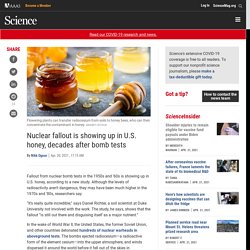
Although the levels of radioactivity aren’t dangerous, they may have been much higher in the 1970s and ’80s, researchers say. “It’s really quite incredible,” says Daniel Richter, a soil scientist at Duke University not involved with the work. Florida is full of invasive species. They’re coming for the rest of us. A Texas city had a bold new climate plan – until a gas company got involved. When the city of Austin drafted a plan to shift away from fossil fuels, the local gas company was fast on the scene to try to scale back the ambition of the effort.

Like many cities across the US, the rapidly expanding and gentrifying Texas city is looking to shrink its climate footprint. So its initial plan was to virtually eliminate gas use in new buildings by 2030 and existing ones by 2040. Homes and businesses would have to run on electricity and stop using gas for heat, hot water and stoves. The proposal, an existential threat to the gas industry, quickly caught the attention of Texas Gas Service. Study points to ship hull coatings as a major source of microplastic pollution. When we hear about microplastic particles polluting the ocean, the usual suspected sources are degraded consumer plastic goods and synthetic textile fibers from washing machines.
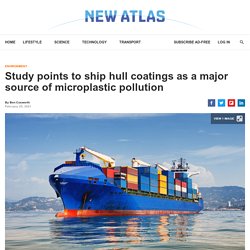
A new study, however, suggests that much of the blame lies with protective hull coatings on ships. Led by Dr. Dead zones: growing areas of aquatic hypoxia are threatening our oceans and rivers. During the early days of the COVID-19 pandemic, physicians were baffled by patients who had no problems breathing—they could still chat away on their cell phone, even though their blood oxygen levels were so low that they should have been unconscious.

How Hurricane Maria’s heavy rains devastated Puerto Rico’s forests. Wind may be the usual suspect for knocking down trees during hurricanes, but a new survey of forest damage in Puerto Rico after back-to-back hurricanes in 2017 highlights the power of a strong downpour.
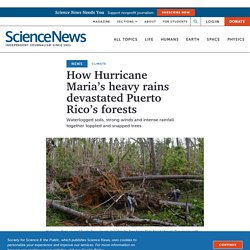
When Hurricane Irma passed off the coast of Puerto Rico on September 6, 2017, the storm brought heavy rains but minimal forest damage. Hurricane Maria, which struck two weeks later, was a different story. The strongest hurricane to make direct landfall in Puerto Rico in almost a century, Maria brought wind speeds over 200 kilometers per hour and dropped nearly 1.5 meters of rain in two days on some areas.
France’s Deadly Seaweed. Article body copy André Ollivro has spent years stomping around the beaches of Brittany, France, putting on a show for the cameras.
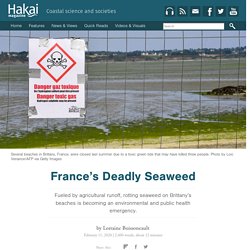
Sometimes he wears a gas mask and carries a hydrogen sulfide monitor. Visiting One of the Last Fragments of Miami's Eccentric Native Forest. It’s January in Florida—divine, sun-soaked, not humid enough to be buggy—and Frank Ridgley is driving a golf cart across the sprawling grounds of Zoo Miami.
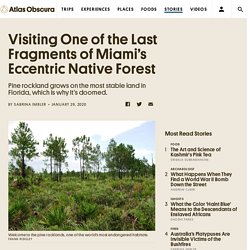
The zoo is home to many endangered species, from the native Florida bonneted bat to the African painted dog, but on this day it’s not an animal Ridgley is going to see. Behind its menagerie, Zoo Miami hosts one of the world’s most endangered habitats: pine rockland forest. A Decade Later, the Deepwater Horizon Oil Spill Has Left an Abyssal Wasteland. Clifton Nunnally felt sick before he even saw the seafloor.

It was 2017 and he had come down with a virus on a month-long research cruise; he was recuperating in his room to avoid infecting his colleagues at the Louisiana University Marine Consortium (LUMCON). From 6,000 feet below, a remotely operated vehicle (ROV) was transmitting a live feed of the site of the Deepwater Horizon accident—the first images of it taken since 2010. Releasing some four million barrels of oil over 87 days, it was the largest accidental marine oil spill ever recorded, a seething, black apocalypse across hundreds of square miles in the Gulf of Mexico. Nunnally shuffled down to the vessel’s control room to see what the ROV found. In his years as a deep sea biologist, he has learned that disasters like this take a long time to recover from, and that the deep site would likely still be dramatically affected by the spill.
Unsurprisingly, deep-sea biologists are under no such illusions. The largest seaweed bloom ever detected spanned the Atlantic in 2018. During the summer, vast, floating islands of Sargassum algae can blanket entire parts of the tropical Atlantic Ocean. The algae reached their largest extent on record in June 2018, forming a giant brown belt that extended for 8,850 kilometers from the west coast of Africa into the Gulf of Mexico. At least 20 million metric tons of Sargassum made up the belt, the largest bloom of seaweed ever detected, researchers say.
Satellite data tracking the extent of the mats over the last 19 years reveal a sudden, dramatic increase in the summer of 2011, and recurring almost every year since, the scientists report in the July 5 Science. These annual massive mats of seaweed, which the researchers have dubbed the great Atlantic Sargassum belt, have been fueled in part by increasing nutrients pouring into the ocean from the Amazon River, the study suggests. Forests can both filter and regulate the flow of water from land to ocean. Sargassum seaweed in ocean stretches from Gulf of Mexico to Africa. There’s a mass of seaweed in the Atlantic Ocean that last year, at its peak, was so large it stretched all the way from the Gulf of Mexico to West Africa. It’s the biggest bloom of seaweed ever recorded, according to a new paper published in Science. And it’s likely another example of how human activity is radically changing the surface of the planet.
The giant seaweed mass is both expansive and heavy, weighing a whopping 20 million tons last year. Decades after it was discovered, pollution continues migrating beneath Socorro. SOCORRO, NEW MEXICO—Just north of Socorro, a squat, square building sits on the west side of Interstate-25. There’s a gate across the driveway, but it’s wide open. And it’s easy enough to drive right onto the Eagle Picher Carefree Battery Superfund site. Groundwater contamination devastates a New Mexico dairy – and threatens public health.
For months, Clovis dairy farmer Art Schaap has been watching his life go down the drain. Instead of selling milk, he is dumping 15,000 gallons a day – enough to provide a carton at lunch to 240,000 children. Instead of working 24/7 to keep his animals healthy, he’s planning to exterminate all 4,000 of his cows, one of the best herds in Curry County’s booming dairy industry. The 54-year-old second-generation dairy farmer learned last August that his water, his land, his crops – even the blood in his body – were contaminated with chemicals that migrated to his property from nearby Cannon Air Force Base. Why Are There So Many Pigeons? They peck at the pavement; they coo overhead; they swoop in hundreds across town squares: Pigeons have become such a permanent fixture in our urban landscapes that cities would seem oddly vacant without them.
But while many people harbor resentment for these ubiquitous creatures — labeling them "rats with wings" — few of us stop to ponder how pigeons became so numerous in the first place, and what our own role in their urban colonization might be. Today, in fact, there are more than 400 million pigeons worldwide, most of which live in cities. A Huge Misconception About Meat-Eating: Cows Are Not Killing the Climate.
As the scale and impacts of climate change become increasingly alarming, meat is a popular target for action. The Coming Worm Apocalypse Should Terrify You. Sewage detectives scour wastewater for drugs. Mysterious Double Whirlpools Appearing in Ocean. Marine life can tear a single plastic bag into 1.75 million tiny pieces. The Thermodynamic Theory of Ecology. (Almost) no natural disasters are natural. Who’s the world’s leading eco-vandal? It’s Angela Merkel. Which living person has done most to destroy the natural world and the future wellbeing of humanity? Donald Trump will soon be the correct answer, when the full force of his havoc has been felt.
WATCH: Video shows sinkhole swallowing part of Florida home. A family in Apopka in central Florida narrowly escaped a giant sinkhole that was caught on camera swallowing a huge portion of their house Tuesday morning. Guess What's Showing Up In Our Shellfish? One Word: Plastics. Shellfish biologist Sarah Dudas works with an oyster specimen at her Vancouver Island University lab.
Florida’s best defense against natural disasters is nature. The Marsh at the End of the World – Guernica. Salvinia molesta - Wikipedia. Creature From the Green Lagoon. A Requiem for Florida, the Paradise That Should Never Have Been. ORLANDO, Fla. Chernobyl’s Hot Mess, “the Elephant’s Foot,” Is Still Lethal. It’s So Absurd and Crazy It Might Just Work: China Plants Billions of Trees in the Desert – Mother Jones.
So, about all that plastic in the ocean... Study: Swapping beans for beef would put serious dent in greenhouse gas emissions. Remote island has 'world's worst' plastic rubbish density. Earth - Terrifying 20m-tall 'rogue waves' are actually real. Sciencemag. The ocean cleanup unveils breakthrough new design ready to start work in 2018. The Doomsday Glacier - Rolling Stone. How Electrified Steel Could Suck Toxic Metals From the Ocean. Prepare for new wave of biological invaders, warn scientists - New Atlas.
A Massive Lake Of Molten Carbon The Size Of Mexico Was Just Discovered Under The US. Theconversation. For the first time on record, human-caused climate change has rerouted an entire river. Researchers: Antarctica's sleeping ice giant could be waking soon. 3D image of Antarctica offers clearest picture yet of ice coverage. How To Make Farmers Love Cover Crops? Pay Them. Did humans create the Sahara Desert? EarthRx: How Community Mycoremediation Projects Can Clean Up Oil Spills Around the Planet. Antacid for the atmosphere could cool down planet Earth. Sprinkling of sawdust could soak up Arctic oil spills. What do Earth's magnetic fields tell us about warming oceans? Arctic soils: a ticking climate time bomb. In Huge Win for Oceans and Wildlife, California Phases Out Plastic Bags.
The Nasty Fallout from North Carolina's Powerful Hog Industry. Fossils reveal approaching relocation of plants on Earth – HeritageDaily. Atmospheric acidity almost back down to preindustrial levels. Theconversation. Your drain on drugs: Meth seeps into Baltimore's streams. Earth - Five surprising uses of poo. Theconversation. Study looks at long-term impact of farming. Fallout from Fukushima: The Radioactive Exclusion Zone. From suicidal shrimp to spiked tap water: where unused medications end up — Hopes&Fears — flow "Wellness" Fredrik ausinsch imagines collector drone for algae abundance in the baltic sea. From rainforest to your cupboard: the real story of palm oil - interactive. Indonesia is burning. So why is the world looking away? Chilling Photos Show Coral Bleaching Across the Globe.
At site of world's worst nuclear disaster, the animals have returned. There are now 3.04 trillion trees on earth. Scientists track subsurface waves the size of skyscrapers. The Climate Deception Dossiers: Internal Fossil Fuel Industry Memos Reveal Decades of Corporate Disinformation. “Faith-based arguments that deal with climate change are a smokescreen that mask the real problem”
An 8-year-old Falls Into One of Mexico’s Most Contaminated Rivers. 18 Days Later, He’s Dead. Earth's oceans found to be a much greater source of greenhouse gas than previously believed. Let’s just re-engineer the climate — Bull Market. Fukushima Seaborne Radiation Has Reached North American Shores. Thoughts on the Apocalypse: Fight for What You Love by Derrick Jensen - Terrain.org: A Journal of the Built + Natural Environments.
What really caused the Chernobyl disaster? Dozens of new craters suspected in northern Russia. An Iceberg Flipped Over, and Its Underside Is Breathtaking. There Were Too Many Deer In The Forest. So They Unleashed The Wolves Without Any Idea What Would Happen. A 2,500 Square-Mile Methane Plume Is Silently Hovering over Western US. Underwater robot provides first detailed, high-resolution 3D maps of Antarctic sea ice. 'Aquatic Osteoporosis' Jellifying Lakes. Watch Leave It to Beavers. American forest fires are melting the ice on Greenland. Limits to Growth was right. New research shows we're nearing collapse.
Integral Sustainability: Correlating Action Logics with Sustainability to Provide Insight into the Dynamics of Change. It's personal: why leaders don't turn climate knowledge into action. Losing Ground. Hundreds of Methane Plumes Erupting Along East Coast. Infertility in Spanish Pigs Has Been Traced to Plastics. A Warning for Humans? Iron from Melting Ice Sheets May Help Buffer Global Warming. Global Extinction...Within One Lifetime? This Will Shatter Your View of Apex Predators: How Wolves Change Rivers. 'Rivers On Rolaids': How Acid Rain Is Changing Waterways.
Japan government abandons hands-off approach to Fukushima clean-up. Sustainable seafood is a fantasy.